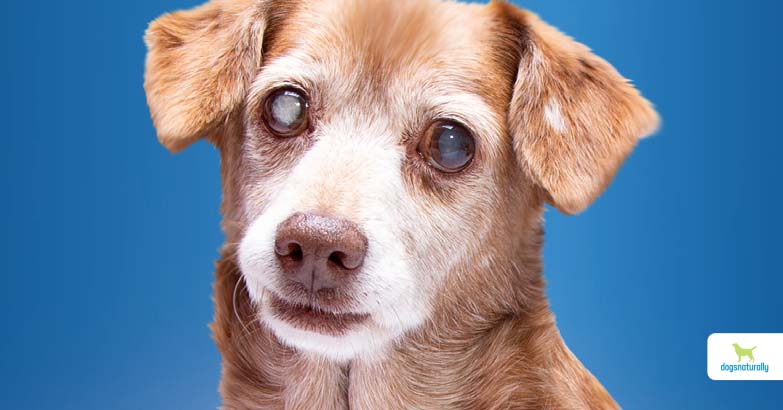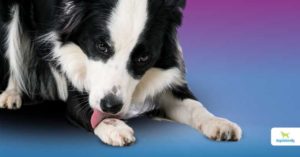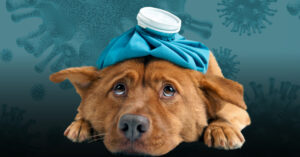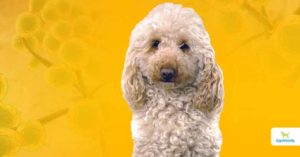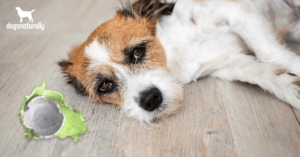In humans, cataracts are normal. They’re considered to be a part of aging. But … did you know your dog can get cataracts, too?
What Are Cataracts In Dogs?
Eyes have protein and water in them. Canine cataracts happen when the proteins of your dog’s eyes clump together and form a cloudy film. The film blocks light in your dog’s eye and may cause some vision loss. Eventually, the proteins continue gathering, and the entire lens can become cloudy. If this covers your dog’s lens, then she can be completely blinded.
If you’re reading this article, you may have a dog with cataracts … or you wonder if your dog has them. Perhaps you’re trying to prevent cataracts in your dog … or you want to try to reverse your dog’s cataracts. Or you might even be considering cataract surgery for your dog.
Cataracts in dogs are quite common. Usually, veterinarians will tell you surgery’s the only option to stop your dog from going blind. But cataracts have different causes … and there are things you can do to help prevent them and manage them naturally.
So take a deep look into your dog’s eyes. She’s going to look back at you adoringly. But loving looks aren’t the purpose of this quick exercise. The goal is to examine her pupils, and really look at them.
Are they cloudy? Are they clear? That can give you some clues.
PRO TIP
If they’re cloudy but bluish, your dog might have lenticular sclerosis (also called nuclear sclerosis). It’s a different condition that doesn’t usually cause blindness.
Dog Eye Anatomy
Though the eyes of your dog are very similar to your own eyes … there are some differences.
- Dogs and other animals have three eyelids, compared to our two. In addition to the upper and lower eyelid, they also have a third, usually invisible eyelid.
- The cornea is the part of the eye you see, and where ulcers can happen. Light reflects off the back of the eyelid through the clear part of the eye. That’s the cornea.
- The iris is the colored part of the eye.
- The pupil, the black center of the eye, controls how much light gets in. In bright light, the pupil is smaller. In low light, the pupil gets bigger.
- Behind the iris is the lens, which focuses light back to the retina.
- The thin membrane that protects the sclera (see below) is the conjunctiva.
- The glands provide an oily fluid that lubricates the lids so they don’t stick when blinking.
- The sclera, or the white of the eye, is relatively tough. If your dog’s eyes are bothering her, they’ll change color. They may look reddish or pink, meaning they’re irritated or sore.
What Causes Cataracts In Dogs?
Cataracts come with old age for humans, so we expect them to come with old age for dogs too. And that’s true … in part. But there are other possible causes of cataracts in dogs. These include …
- Diabetes mellitus
- Eye injury or inflammation
- Trauma
- Birth defects
- Toxic chemical exposure
- Electric shock
- Nutritional deficiency (in newly weaned puppies, also hypocalcemia)
- Immune or other chronic disease*
- Inherited disease
- Smoking (don’t let your dog breathe second-hand smoke)
*According to veterinary homeopath Richard S Pitcairn DVM PhD … dogs with immune disorders or chronic skin conditions, hip dysplasia, or ear problems, often develop cataracts as they age.
Hereditary Cataracts
Most dogs’ cataracts are hereditary. More than 100 dog breeds are known to get cataracts. There are some gene mutations that make your dog more susceptible to cataracts. But … not having the mutation doesn’t mean she won’t get cataracts.
Breeds prone to cataracts include …
- American Staffordshire Terrier
- Boston Terrier
- Silky Terrier
- West Highland White Terrier
- Australian Shepherd
- Bichon Frise
- Cocker Spaniel
- French Bulldog
- Havanese
- Labrador Retriever
- Miniature Schnauzer
- Poodle
- Siberian Husky
Always make sure you research your breed so you know what to expect.
Cataracts From Diabetes
Diabetes is a well-known cause of cataracts in dogs. And it comes on fast. Most diabetic dogs develop cataracts within a year of their diabetes diagnosis. If your dog is diabetic, check her eyes daily. Sometimes cataracts can appear within days … so the sooner you take action, the better.
RELATED: How to manage diabetes in dogs …
How To Recognize Cataracts
First, a word about eye problems generally. Sometimes your dog will get a minor eye irritation, injury or infection (like conjunctivitis). You can usually manage these yourself with home remedies. But when your dog’s eyesight is at risk, it’s smart to play it safe.
You’ll want to check in with your vet If your dog’s eyes are inflamed … especially if they’re bulging, swollen and red. Your pup is likely in pain (just like you would be if your eyes were sore). If inflamed eyes aren’t treated, they can lead to very painful glaucoma. Your vet may also refer you to a veterinary eye care specialist, and it’s definitely a good idea to see a real eye expert.
RELATED: Find out when you should head to the vet with eye problems …
But what do cataracts look like? In their early stages, cataracts are called incipient. Later stage cataracts are classed as immature, mature or hypermature.
Cataracts often appear in stages, where the eye begins clouding over gradually. Cataracts can start as small dots or white lines that expand in time to cover more of the eye. So you may notice your dog’s eye looks slightly cloudy or whitish, with a clear outer layer. The cloudiness will grow over time.
In some dogs, though, cataracts can pop up seemingly overnight, or over the course of a few days.
Your dog may have some discharge or runny eyes. You may see her pawing or rubbing her eyes too. In time, she may seem clumsy, or bump into things and need some help getting around.
PRO TIP
Cataracts can appear in one or both eyes. Unilateral cataracts are caused by trauma, birth defect or another health problem.
If your dog is already showing signs of cataracts, all hope is not lost. That’s because …
- Not all cataracts progress beyond early stages.
- Not all dogs with cataracts become blind.
- Even blind dogs can have active, exciting lives.
But you do need to recognize when your dog is losing her sight.
Signs Your Dog Is Going Blind
Because cataract blindness can be gradual, you might not nice the milky layer forming on your dog’s eyes. But you might notice her behavior has changed.
- Is your favorite good girl suddenly less interested in playing?
- Is she reluctant go outside?
- Does she seem scared of the dark?
- Is she sleeping more than normal?
- Is she acting clumsily, banging into things?
If you notice any of these things … especially if you see cloudy eyeballs, it’s time for a vet visit.
RELATED: Learn more about dealing with blindness in dogs …
How Vets Diagnose Cataracts
Your vet will perform a thorough eye exam to confirm whether your dog has cataracts. He should assess …
- Extent and density of cataracts
- Speed of change
- Level of eye inflammation
- Amount of vision loss
He may refer you to an eye specialist for more advanced testing. This could include ultrasounds or electroretinography. (This test measures the electrical response of cells in the retina). They may do routine diagnostics like bloodwork to rule out other disease.
Treatment Of Cataracts In Dogs
Veterinarians say there’s no known way to reverse or even slow the progression of cataracts. In immature cataracts, your vet may suggest eye drops until cataracts progress further. But generally, they’ll tell you cataract surgery is the only option. And they’ll recommend doing the surgery sooner, rather than later.
But is that really true? Studies have looked at medical management (vs surgery) of canine cataracts, without much success. However, there’s some encouraging research, for both people and dogs with cataracts.
A 2015 University of California study found that treatment with lanosterol (a cholesterol-like molecule) can reduce cataract severity. In fact, there’s now at least one company offering lanesterol eye drops for dogs. However, this is a very new product and safety is questionable. They claim to treat all stages except hypermature cataracts. But the research says that drops alone aren’t effective without injected lanosterol as well. So you might want to ask your vet to find out more..
Other researchers have found a dipeptide called N-Acetylcarnosine may also reverse or improve age-related cataracts.
If these treatments become available, they could be life-changing for many … especially in developing countries where cataract surgery isn’t available.
But there are still natural steps you can take to slow the progression of cataracts. Nutrition to support the eyes is extremely important. And some herbs or supplements can help … so read on to learn about these.
First, what’s involved in cataract surgery?
Cataract Surgery For Dogs
Cataract surgery is an outpatient procedure. First they’ll give your dog a few days of medications to prepare the eyes.
Your dog will be under general anesthesia for about an hour. Here’s the procedure …
- The surgeon makes a small incision at the corner of the eye.
- Then they remove a small circular portion of the lens capsule.
- They “vacuum” out the cataract fibers ultrasonically.
- Then they place an artificial lens into the eye.
Your dog should be discharged 2-3 hours after surgery. They’ll give you topical medications to use at home for the post-operative period. Your dog may have stitches and might need a cone for a few days.
But what about complications? They do happen sometimes … even though success rates have improved a lot, thanks to recent microsurgical techniques.
Complications of Cataract Surgery
There can be complications in 5% to 10% of patients, including …
- Breakdown of the tissue or suture material (incision dehiscence)
- Infections at the surgical site (which could spread to other areas)
- Corneal ulcerations
- Corneal scarring, vascularization, or mineralization
- Eye inflammation (uveitis)
- Glaucoma (increased intraocular pressure)
- Retinal detachment or degeneration
- Bleeding inside the eye (hyphema)
- Displacement of the intraocular lens implant
Some of these complications are severe and can cause discomfort … even blindness. Others can be treated if they’re caught early. So surgery isn’t without some danger. Talk to your veterinary surgeon about the likely risks for your dog.
And of course, cataract surgery isn’t cheap.
How Much Is Canine Cataract Surgery?
Cataract surgery costs vary depending on whether your dog needs surgery on one or both eyes. Prices range from $1,500 per eye up to as much as $4,000 per eye. Other health issues could add to the cost … and where you live also makes a difference (look out for big city prices!).
So … if you have insurance for your dog, this surgery would be a good time time to use it!
But perhaps you can avoid surgery altogether.
How To Manage Dog Cataracts Naturally
A balanced, healthy diet is one of the biggest things you can provide to help with your dog’s cataracts. As always, feed a whole foods, preferably raw diet. Avoid processed, starchy foods like kibble.
Then add some eye-strengthening foods and supplements to your dog’s diet.
What Nutrients Help The Eyes?
Your dog’s diet should include foods that can help with canine eye health:
- Eggs: eggs are a great source of vitamin A, lutein, and zeaxanthin. These have all been shown to lower cataract risk.
- Lean meats: an ideal source of eye-supporting zinc.
- Orange foods: carrots and pumpkin are just two examples of carotene-rich foods
- Blueberries: full of antioxidants, blueberries can support your dog’s eye health
- Green leafy vegetables: veggies like broccoli and kale are rich in phytonutrients
- Foods rich in Vitamin E: spinach, almonds, wheat germ oil, avocado, olive oil
DNM RECOMMENDS: Four Leaf Rover offers Red Rover, a powerful blend of certified organic raspberries, blueberries, apples and cranberries, plus astaxanthin for extra antioxidant power. Buy Red Rover now >>
PRO TIP
Give your dog eyeballs! Feeding the organ you want to support is a long tradition in natural medicine. If you can get them (try a local abbatoir or old-fashioned butcher), put some eyeballs in your dog’s bowl. They’re full of nutrients for her eyes.
Herbs And Supplements For Eyes
There are a few supplements and herbs that can support your dog’s eye health.
- Omega-3 fatty acids: these essential fats are well known for their eye health benefits. It’s best to avoid fish oil, which depletes the oceans and is often contaminated. Instead, add a clean, sustainable source of omega-3 fatty acids.
- Astaxanthin. This is the same antioxidant that turns salmon, shrimp and flamingos pink!)
- Grape Seed Extract. An antioxidant that’s been shown to slow cataract development.
- Eucalyptus Honey. Some herbalists claim this can help reduce opacity of the lens. Dab a small amount of honey inside the lower lid every day for a few weeks.
- Hachimijiogan. Research has shown this Chinese herbal formula can slow progression of cataracts. Start this in early stages if possible. It may help with diabetic cataracts.
- Bilberry Extract With Vitamin E. Studies show this combination can help stop progression of cataracts.
- Alpha-Lipoic Acid. In vitro studies show this antioxidant may help protect the lens from damage. It also shows promise in preventing diabetic cataracts.
- Cineraria Homeopathic Eye Drops. Expert herbal vet Dr Susan G Wynn finds that homeopathic eyedrops made from the juice of Cineraria maritima can be effective in eliminating cataracts. Dilute drops by half with sterile saline so they don’t sting your dog’s eyes. You’ll need to give the drops for 6 months. They’re available at online sources.
- Ocu-GLO RX. This natural supplement contains lutein, grapeseed extract, omega-3 fatty acids and alpha-lipoic acid. It’s an antioxidant formula that supports lens health. It may slow cataracts, especially in diabetic dogs.
RELATED: How to prevent and manage eye problems naturally …
Can You Prevent Canine Cataracts?
There are many things you can do to boost your dog’s overall health. This can lower the risk of cataracts, especially as she ages.
First, treat any underlying conditions or injuries that could lead to cataracts. These include long term problems like autoimmune disease, skin or joint conditions. As mentioned earlier, Richard Pitcairn DVM PhD has noted that many dogs with these chronic problems develop cataracts.
Avoid Over-vaccination
Only give your dogs the vaccines she really needs. Many vets over-vaccinate dogs by giving them unneeded yearly or triennial shots. Decades of research proves that puppy vaccines given at the right time will protect your dog for life. Vaccinations can disrupt your dog’s normal immune response. This leads to chronic conditions like autoimmune disease … and could make your dog more susceptible to cataracts.
Correct Nutritional Imbalances
You’ll also need to correct any nutritional deficiencies that can cause cataracts …
Puppy Nutritional Cataracts
Puppies can develop cataracts when they’re fed commercial milk replacers without arginine. Arginine’s an essential amino acid in dogs. It’s plentiful in meat and fish, so puppy cataracts usually go away with a good diet.
Hypocalcemia
Hypocalcemia (low blood calcium) can have many causes … so it may not be just nutritional. That means you might need your vet’s help investigating the reason. It could be thyroid, kidney, or pancreas-related, to name a few. Hypocalcemia can affect many functions in the body, including vision. Cataracts can develop after long-term hypocalcemia … so it’s important to get to the bottom of it.
Avoid Injury
Then there are other steps you can take to avoid injury or accidents that could lead to cataracts. Some causes aren’t within your control … age being one of them). But you can make sure your dog and her environment are as safe as possible.
Store Toxic Chemicals
Be sure to put any chemicals away. Store your cleaning, pool, yard herbicides, pesticides or painting supplies somewhere your dog can’t get into them.
Hide Sharp Objects
If your home or hard has sharp objects at your dog’s eye height, make the area safer.
Protect The Eyes
Consider buying sunglasses or goggles to protect her eyes from the sun and pointy objects. (Bonus: dog sunglasses, or “doggles” are SUPER cute!)
Keep Baths Safe
Be careful when giving your dog a bath. Sulfates like sodium lauryl sulfate (SLS) and sodium laureth sulfate (SLES) are irritants. They’re linked to the development of cataracts in young pets. They may also permanently damage protein formation in the eyes, leading to blindness. (Of course, always be careful using any shampoo around your dog’s eyes.)
Check the label of your dog’s shampoo for these sulfates, and look for natural shampoo without these ingredients:
Canine cataracts are serious, but they don’t have to be scary. With quick action and a natural lifestyle, you can help your best friend have a happy, healthy life. She may not have the same eyesight she had as a puppy, but she’ll adapt. Even completely blind dogs can lead full, active, happy lives!
References
Miller EJ, Brines CM. Canine Diabetes Mellitus Associated Ocular Disease. Top Companion Anim Med. 2018 Mar;33(1):29-34.
Babizhayev MA et al. Lipid peroxidation and cataracts: N-acetylcarnosine as a therapeutic tool to manage age-related cataracts in human and in canine eyes. Drugs R D. 2004;5(3):125-39.
Babizhayev MA Efficacy of N-acetylcarnosine in the treatment of cataracts. Drugs R D. 2002;3(2):87-103.
Dubois VD, Bastawrous A.N-acetylcarnosine (NAC) drops for age-related cataract. Cochrane Database Syst Rev. 2017 Feb 28;2(2):CD009493.
Lim CC et al. Cataracts in 44 dogs (77 eyes): A comparison of outcomes for no treatment, topical medical management, or phacoemulsification with intraocular lens implantation. Can Vet J. 2011 Mar;52(3):283-8. PMID: 21629421; PMCID: PMC3039899.
Zhao L et al. Lanosterol reverses protein aggregation in cataracts. Nature. 2015 Jul 30;523(7562):607-11.
Koushan K et al. The role of lutein in eye-related disease. Nutrients. 2013;5(5):1823-1839. Published 2013 May 22.
CA Barden et al. The Effect of Grape Seed Extract on Canine Lens Epithelial Cells. Investigative Ophthalmology & Visual Science May 2006, Vol.47, 2541.
Age-Related Eye Disease Study 2 Research Group. Lutein + zeaxanthin and omega-3 fatty acids for age-related macular degeneration: the Age-Related Eye Disease Study 2 (AREDS2) randomized clinical trial. JAMA. 2013 May 15;309(19):2005-15.
McCusker MM et al. An eye on nutrition: The role of vitamins, essential fatty acids, and antioxidants in age-related macular degeneration, dry eye syndrome, and cataract. Clin Dermatol. 2016 Mar-Apr;34(2):276-85.
P F Jacques, L T Chylack, Jr. Epidemiologic evidence of a role for the antioxidant vitamins and carotenoids in cataract prevention, The American Journal of Clinical Nutrition, Volume 53, Issue 1, January 1991, Pages 352S–355S
Fursova AZh. Dietary supplementation with bilberry extract prevents macular degeneration and cataracts in senesce-accelerated OXYS rats]. Adv Gerontol. 2005;16:76-9. Russian. PMID: 16075680.
Kamei A, Hisada T, Iwata S. The evaluation of therapeutic efficacy of hachimi-jio-gan (traditional Chinese medicine) to mouse hereditary cataract. J Ocul Pharmacol. 1988 Winter;4(4):311-9.
Kamei A, Hisada T, Iwata S. The evaluation of therapeutic efficacy of hachimi-jio-gan (traditional Chinese medicine) to rat galactosemic cataract. J Ocul Pharmacol. 1987 Fall;3(3):239-48.
Williams DL. Effect of Oral Alpha Lipoic Acid in Preventing the Genesis of Canine Diabetic Cataract: A Preliminary Study. Vet Sci. 2017 Mar 16;4(1):18.

